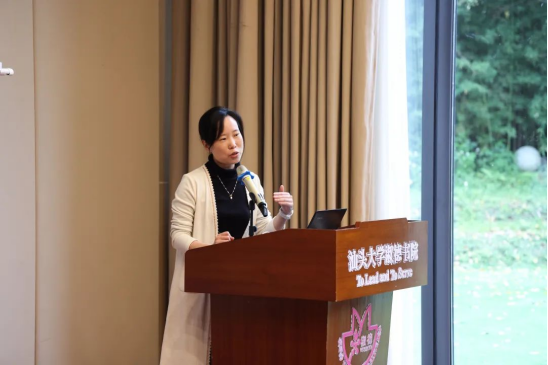On the afternoon of April 4th, 2023, Esther Hall of Shantou University held aSTEAM subject lecturetitled“Prevention and Control of Human Respiratory Virus Transmission: From COVID-19 to H1N1”.Dr. Wang Jia from the Joint Institute of Virology of Shantou University and the University of Hong Kongwas invited to explain how toprevent and control the ubiquitous transmission of respiratory viruses.

Dr. Wang Jia
At the beginning of the lecture, Dr. Wang Jia raised the following questions:
“Have we gotten rid of the COVID-19 virus?”
“Where did the COVID-19 virus go?”
“Can it disappear like SARS did?”
“Will the COVID-19 virus come back again?”
What is a virus?
As the saying goes, “know yourself and know your enemy, and you will never be defeated.”
To deal with viruses, we must firstunderstand what they are.
Here are five characteristics of viruses:

COVID-19

Influenza A Virus
What is the history between humans and respiratory viruses?
From the 1997 outbreak of H5N1 avian influenza infecting humans to the COVID-19 pandemic in 2020,humans have been coexisting with respiratory viruses in an ongoing struggle. From being caught off guard during the SARS outbreak 20 years ago, to the lack of specific antiviral drugs and experience in controlling outbreaks of highly contagious diseases, to the global race for vaccine and drug preparation during the COVID-19 pandemic,humans have gradually accumulated knowledge of respiratory virusesand optimized the means of preventing, controlling, and treating viral infections. To date, the virus continues to evolve, whilehumans are also developing alongside it.
Why can’t some viruses be completely eradicated?

image source: Shanghai Observer
Dr. Wang Jiaexplained thatviruses that can coexist with humans tend to have low virulence. Viruses with high virulence and mortality rates tend to disappear because of the deaths of their hosts (humans).Instead, viruses with less virulence can coexist with their hosts for a long time.Therefore, this type of virus will reappear repeatedly over a long period of time. Due to their low virulence, these viruses generally only cause mild symptoms such as low fever, cold, cough, etc.,and do not endanger the lives of healthy adults.
What is the relationship between viruses and animals?

As natural and intermediate hosts of viruses,animalshave the opportunity to transmit the viruses they carry to humans when they come into contact with them. In past epidemics, many outbreaks originated in places such aslive animal markets. For example, the Wuhan seafood market that triggered the COVID-19 pandemic sold a variety of wildlife in addition to seafood, including the intermediate host of the SARS virus, the civet. Therefore,reducing direct contact with wildlife, optimizing the breeding, transportation, and sale of livestockcan help cut off the transmission of viruses from animals to humans through infectious pathways.

Dr. Wang Jia also explained, in simple terms, from a biological perspective,why viruses can mutate so rapidly within their hosts. She gave an example to illustrate this:avian influenza viruses can be transmitted through feces, and most birds live in water bodies that are shared by many, so the probability of two different viruses entering the same cell is greatly increased, leading toa much higher chance of genetic recombination and the emergence of new biological traits. This mechanism is the basis for the emergence of influenza pandemic strains.
In addition, Dr. Wang Jia also introduced variouspreparation routesfor vaccines andstrategies for developing antiviral drugs.
Q&A

Audience raising questions to Dr. Wang Jia
Q1
Now that China has lifted the controls over pandemic and experienced a large outbreak, the level of antibodies in each person’s body is relatively high. So, with the current situation of the COVID-19 pandemicbeing relatively stable, will there beanother outbreakin a few months?As the virus is always in a state ofmutation and evolution, it will not disappear. However, with the establishment of herd immunity and the weakening of the virus's virulence, it is more likely toexist in a state similar to that of the flu.
I also expect this to be the case. The peak of infection in China was in December. The level of antibodies in people’s bodies is now decreasing, so it may be necessary toadminister a new round of vaccinesoradopt other preventive measuresin the future.

Q2
Some people may experiencesevere symptoms from COVID-19.After being infected with the virus, theirunderlying medical conditionsmay become more serious. How should we deal with this situation?
My suggestion is totreat the disease according to its symptoms.Infection with COVID-19 and becoming ill is a fact, and there is no point in investigating what caused the worsening of the condition.Following medical advice and cooperating with treatmentis the most effective method.

Q3
For people with underlying diseases, should they receive COVID-19 vaccines, and what type of vaccineis more suitable for them?
The recommended type of COVID-19 vaccine varies depending on people’s specific condition.For example, some people have nephrotic syndrome and need to use immunosuppressive drugs. In this case, an inactivated vaccine is completelyinactivated virus, which is equivalent to injecting a protein to stimulate the body to produce an immune response.The worst resultof immunosuppressive drugs isnot producing antibodies, sothe vaccine does not work. However, if a live attenuated vaccine is used, the body of a person using immunosuppressive drugs may not be able to produce immune function to resist.Therefore, it is necessary to analyze the use of medicines and the principles of vaccines by understanding the conditions.

Group Photo
As the Q&A session came to an end, theSTEAM lecturealso drew to a close. It is hoped that after this lecture, everyone has deepened theirunderstanding of respiratory virusesand become the primary health responsibility of themselves.

